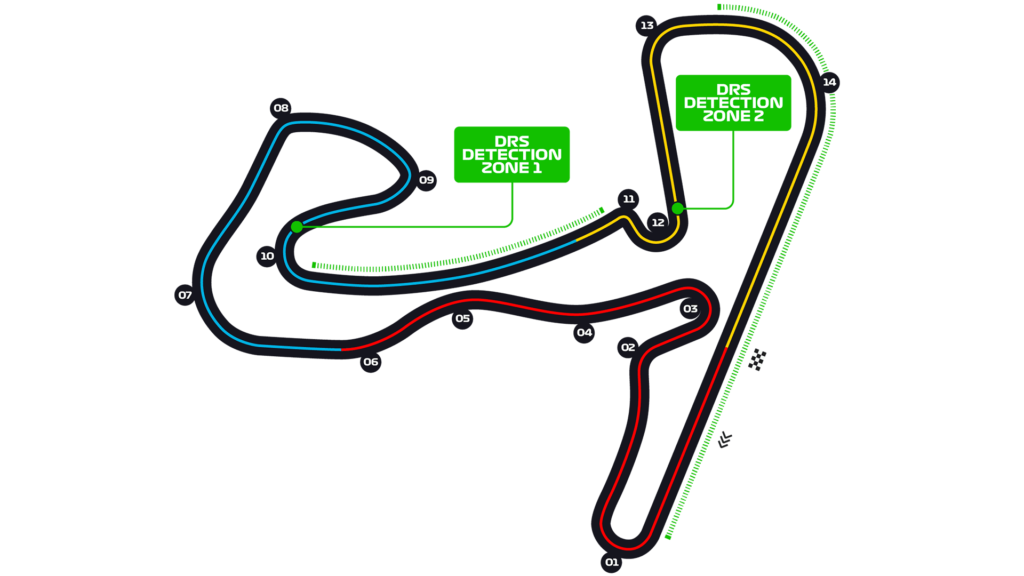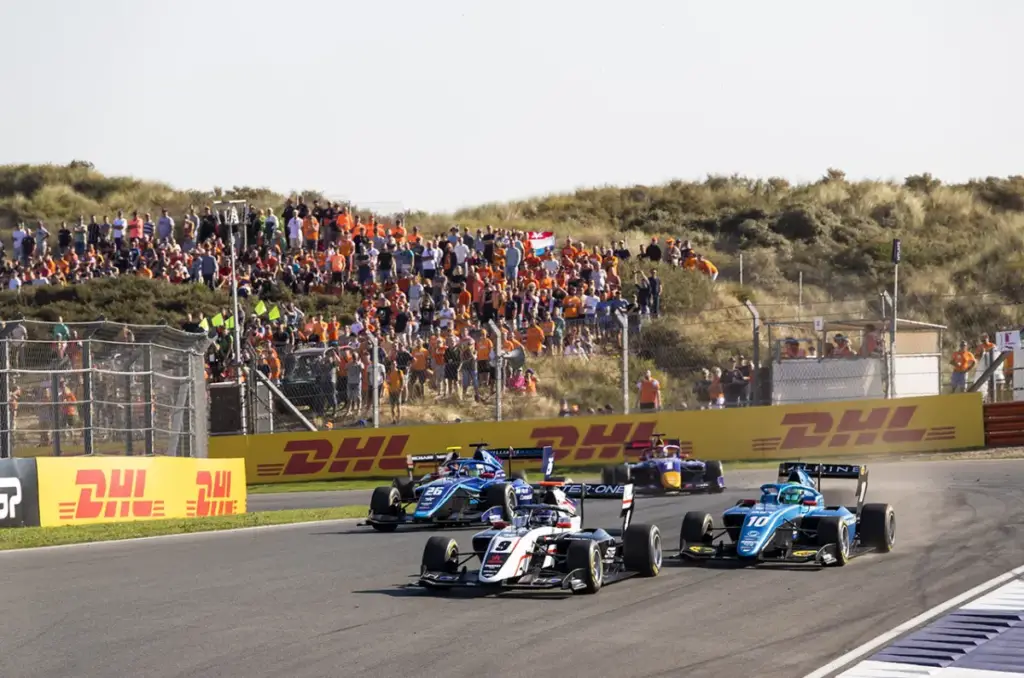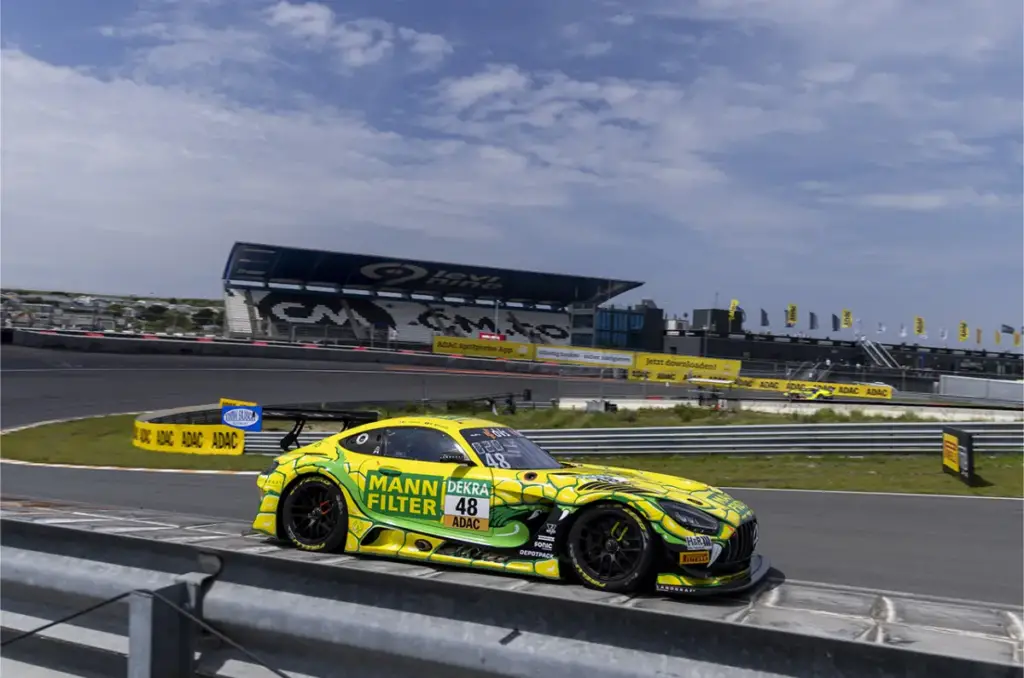Tucked away in the seaside town of Zandvoort, the Circuit Zandvoort is a racing gem. The track was reincarnated on the Formula 1 calendar.
It blends historical significance with modern racing challenges. For an F1 driver, it’s not just about speed – it’s about precision, strategy, and the deft dance of gear changes. Let’s break down the circuit, corner by corner, diving deep into what it takes to dominate this legendary track.
F1worldwide.com Recommends
- Is It Worth Going to the Dutch GP
- Max Verstappen Biography
- Yuki Tsunoda
- All The F1 Drivers as Children
Negotiating Circuit Zandvoort
The following describes how to achieve the best times in an F1 car on the Circuit Zandvoort

Circuit Zandvoort – Tarzanbocht (Turn 1)
- Speed: 80-100 km/h
- Gear: 2nd or 3rd
The most famous corner at Zandvoort starts after a long straight. Braking late and downshifting rapidly, drivers will look to attack on the inside.
It’s a key overtaking point but requires precision to maintain momentum into the next section.
Circuit Zandvoort – Gerlachbocht (Turn 2) and Hugenholtzbocht (Turn 3)

This corner is named in honor of Wim Gerlach, a racing driver who tragically passed away in 1957 following a crash in his Porsche Carrera Speedster.
- Speed: 140-160 km/h
- Gear: 4th
A quick left-right sequence, drivers must balance throttle and steering to avoid unsettling the car. Maintaining momentum without scrubbing off too much speed is vital.
Circuit Zandvoort – Hunserug & Rob Slotemakerstraat (Turns 4 & 5)

In 2020, the hill featuring a gentle yet swift right curve was resurfaced with fresh asphalt, equipped with a new track post, and updated with FIA-compliant fencing on the right. Drivers can also spot the newly established Dutch Grand Prix Lounge on the circuit’s right side.
- Speed: 200-220 km/h
- Gear: 6th
These turns form a fast chicane. Precision is crucial to maintain speed and prepare for the rapid right-hand of Scheivlak.
Circuit Zandvoort – Scheivlak (Turn 6)

Scheivlak, a cornerstone of the CM.com Circuit Zandvoort, has been challenging drivers since its debut in 1948. Starting atop a dune hill, it elegantly slopes to the right. Its long history, paired with the sheer speed at which drivers tackle it, underscores why many racers claim this corner separates the legends from the rest.
The 2020 revamp of the CM.com Circuit Zandvoort introduced several modifications to Scheivlak. Enhancements include a refreshed gravel trap, newly installed FIA fencing on the left, and the substitution of some crash barriers with walls adorned with tire stacks. The curbs were updated and the track post repositioned. Yet, through all these changes, the corner’s iconic and demanding shape remains untouched, continuing to challenge drivers with the same intensity it has for decades.
- Speed: 250 km/h
- Gear: 7th
A high-speed right-hander taken flat out in dry conditions. Boldness and commitment are essential, as any mistake could be costly.
Circuit Zandvoort – Mastersbocht (Turn 7)
After navigating Scheivlak, racers set their sights on Turn 8, known as Mastersbocht. Up until the late 1980s, racers would encounter a left-right combo after Scheivlak. Initially, this section, Hondenvlak, was notoriously rapid.
However, after some time, officials deemed it “too quick,” leading to the creation of the Mastersbocht. This change introduced a tighter corner, forcing drivers to decelerate, thus theoretically slowing their approach toward Tunnel East.
But by the end of the 1980s, this portion post-Mastersbocht ceased to be part of the race and was subsequently dismantled.
By the late 1990s, CM.com Circuit Zandvoort—and Dutch motorsport in general—underwent a significant resurgence. While races took place on a temporary track, plans were set in motion to restore CM.com Circuit Zandvoort to its Grand Prix-length glory.
These blueprints reincorporated the former Slotemakerbocht and Scheivlak and introduced a new section. Instead of the traditional left, racers would now steer right, transforming the new Mastersbocht into a surprising and thrilling feature of the revitalized CM.com Circuit Zandvoort.
Even after 2020’s revamp, Mastersbocht remains a formidable challenge for racers, especially given its high-speed nature. In line with FIA’s preferences, the inner “Ludwig Teller kerbstone” was swapped out for a “sausage kerbstone.”
Additionally, a new asphalt run-off area graces the Mastersbocht’s exit. This provides racers, who’ve momentarily lost control, an opportunity to safely recover without any advantage. They can re-enter the race at Turn 9. The unique double curb ensures that drivers stay within the track limits when exiting the Mastersbocht.
- Speed: 180-200 km/h
- Gear: 5th or 6th
This is a challenging double apex corner. A smooth line and efficient use of throttle ensure a clean exit heading into the next series of corners.
Circuit Zandvoort – Bocht 8 & 9
- Speed: 160-180 km/h
- Gear: 5th
This sequence demands balance and fluidity. Over-aggression can easily see a driver lose time or end up in the gravel.
Circuit Zandvoort – Hans Ernst Bocht (Turn 10)
- Speed: 90-110 km/h
- Gear: 3rd
This is a tight chicane. Braking hard and downshifting to third, drivers need precision to navigate cleanly and set up for the critical following section.
Circuit Zandvoort – Kumhobocht (Turn 11) & Arie Luyendykbocht (Turn 12-13)
- Speed: 270-290 km/h
- Gear: 8th
The end of the lap presents a thrilling, banked section. The cars will ride the banking, using the high-speed nature of these corners to thrust onto the main straight.
Driving Style and Strategy
The driving style employed by the top drivers results in a balance between high speeds and tire degradation.
Drivers concentrate on the following factors.
- Braking Points: Zandvoort requires sharp reflexes, especially at Tarzanbocht and Hans Ernst Bocht. Late braking can open up overtaking opportunities, but precision is crucial to avoid overshooting.
- Gear Management: Smooth gear changes are essential to maintain momentum. Mis-shifts, particularly in the mid-section, can prove costly in terms of lap time.
- Tire Preservation: With many high-speed and high-load corners, managing tire wear is vital. A smoother driving style in the early stages can pay dividends in the race’s closing laps.
Conclusion
Circuit Zandvoort is more than just a series of corners. It’s a test of a driver’s skill, bravery, and adaptability. To shine here, one needs to harmoniously blend speed, gear changes, and a dynamic driving style, turning each corner into an opportunity rather than a challenge.

